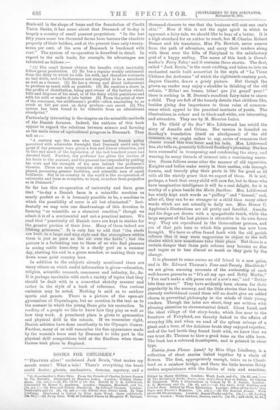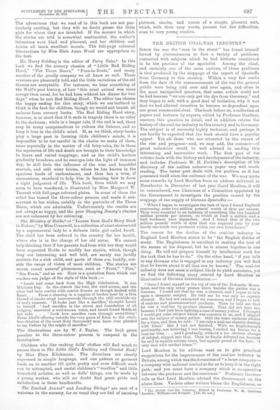BOOKS FOR CHILDREN.* " HEAVENS alive!' exclaimed Jack Bruin, 'that
makes my mouth water! What a tale I There's everything the heart could desire ghosts, enchanters, demons, mystery, and a * (1) Grandmother's Fairy Tales. From the French of Charles Robert Damao by Pia Hewlett. Illustrated by Maurice Lalau. London : William Heine- mann. [0s. net.1—(2) The Child of tho Sea. Retold by S. R. Littlawood. Illustrated by Honor C. Appleton, London: Simpkin, Marshall, and Co. [Sc. net.]—(8) Four-and.Twenty Meal:birds. By Edward Thomas. London: Duckworth and Co, [2s. ed, net.}.—(4) Fairies from Flower Land. By Olga Lindberg. Illustrated in Colour by Elsie Anna Wood. Same publishers. 6d.]—(5) Fairy Tales. With 48 Coloured Plates by Margaret W. Tarrant. thousand chances to one that the business till coat one one's skin?" Now if this is not the right spirit in which to approach a fairy-tale, we should like to hear of a better. It is a high standard for an author to reach, but M. Charles Robert Dumas and his translator, Miss Pia Hewlett, never swerve from the path of adventure, and carry their readers along with them over the hills of Fairyland to the satisfactory goal of a happy ending. The name of this book is Grand- mother's Fairy Tales,' and it contains three stories. The first, called "Jack Bruin," is the most exciting, and takes us into an enchanted castle built somewhat in the style of "Le Vieux Chateau des Ardennes " of which the eighteenth-century poet, Jaques Cazotte, draws a grisly picture. But though the grown-up reader may enjoy a shudder in thinking of the old refrain, " ma bonne, belasi ciue j'ai grand' peur I" there is nothing in M. Dumai's excellent fairy-tales to alarm a child. They are full of the homely details that children like, besides giving due importance to those rules of common- sense which appeal to the practical instincts of youth. The illustrations, in colour and in black-and-white, are interesting and attractive. They are by M. Maurice Lalan.
In The Child of the Seas Mrs. Littlewood has retold the story of Amadis and Oriana. Her version is founded on Southey's translation (itself an abridgment) of the old romance, or, we ought rather to say, series of romances that cluster round this true lover and his lady. Mrs. Littlewood has, she tells us, generally followed Southey's phrasing. She has been successful in transposing and condensing the story, and weaving its many threads of interest into a convincing narra- tive. Scene follows scene after the manner of old tapestries. Knights and ladies make merry in their castles, ride through forests, and bravely play their parts in life for good or ill with all the stately grace that we expect of them. It is not, perhaps, a book that every child will care for, but to those who have imaginative intelligence it will be a real delight, for it is worthy of a place beside the Morte,Darthur. Mrs. Littlewood has wisely kept such words as " palfrey " and " damsel," and, after all, they can be no stranger to a child than many other words which are not actually in daily use. Miss Honor C. Appleton's illustrations are all pretty and fanciful. Amadis aild his dogs are drawn with a sympathetic touch, while the large serpent of the last picture is attractive in its own fierce way. They are reproduced in the three-colour process, and are of that pale tone to which this process has now been brought. We have so often found fault with the old garish colours that it may seem ungracious to object to the soft shades which now sometimes take their place. But there is a certain danger that these pale colours may become so dim and vague as to loge almost as much as they gain by the change.
It is pleasant to come across an old friend in a new guise, and in Mr. Edward Thomas's Foux-and-Twenty Blae1doirds3 we are given amusing accounts of the authorship of such well-known proverbs as " It's all my eye and Betty Martin," "You can't make a silk purse out of a sow's ear," and " Better late than never." They have evidently been chosen for their popularity in the nursery, and the little stories that have been cleverly embroidered round them will no doubt give an added charm to proverbial philosophy in the minds of their young readers. Though the tales are short, they are written with pleasing attention to circumstantial detail. Giant Land, and the ideal village of the story-books, which lies near to the frontiers of Fairyland, are thereby linked to the affairs of everyday life, and when we read of the sylvan menage of a giant and a bear, of the delicious broth they enjoyed together, and of the bad broth they found fault with, we know that we can trust Mr. Thomas to blow a good tune on the elfin horn. The book has a coloured frontispiece, and is printed in clear
type.
Fairies from Flower Land; by Miss Olga Lindberg, is a collection of short stories linked together by a chain of flowers. The first, appropriately enough, takes us to Cloud- land on a rainbow bridge, and there the little heroine Betty makes acquaintance with the fairies of rain and sunshine.
Edited by Harry Golding, London: Ward, Look, and Co. Ps. dd. net-1— en The Ministry of Holda: Leaves from God's Story Book in Nature. By Clarice M. Cresswell. With 8 illustrations in Colour by W. J. Taylor. London: A. R, Mowbray and Co. [2e, 6d. not,]—(7) The Little Girls' Knitting and Crochet Book. Edited by Flora Kliokmann. London : Oillee 011ie Girls Own Paper and Woman's Magazine. [Is, not.]—(8) The Rosebud Annual. With about 200 Illustrations. London: James Clarke and Co. [8s.]—(9) Leading Strings. London : Wells Gardner, Herten, and Co. [Is. 8d. ; and cloth, 20.
The adventures that we read of in this book are not par- dicularly exciting, but they will no doubt please the little .girls for whom they are intended. If the manner in which the stories are told is somewhat sentimental, the author's .intentions were kind and pleasant, and her children and fairies all teach excellent morals. The full-page coloured • illustrations by Miss Elsie Anna Wood are appropriate to the text.
Mr. Harry Golding is the editor of Fairy Tales.5 In this book we find the nursery classics of " Little Red Riding Hood," " The Throe Bears," "Puss-in-Boots," and many another of the goodly company we all know so well. These versions are pleasantly told, and the little variations of the old themes are acceptable. For instance, we hear something of the Wolf's past history, of how " this cruel animal was more Savage than usual, for he had been without his dinner for two days" when he met Red Riding Hood. The editor has chosen the happy ending for this story, which we are inclined to think is the best for children, though we would not banish all
sadness from nursery books. The Red Riding Hood story, however, is so short that if it ends in tragedy there is no relief to the darkness; while in a longer tale, if the end is sad, there may be many compensations to redress the balance, and so keep it true in the child's mind. If, as we think, story-books play a large part in forming little children's minds, it is impossible to he too careful in the choice we make of them, more especially in the matter of old fairy-tales, for in these the mysteries of life and death are brought to their knowledge in brave and varied trappings; and as the child's horizon gradually broadens, and he emerges into the light of Common day, he still feels the influence of the wise and beautiful mortals, and still wiser fairies, whom he has known in the spacious lands of enchantment, and thus has a true, if unconscious, standard to help bins in learning bow to form
a right judgment of life, This book, from which we may see in to have wandered, is illustrated by Miss Margaret W. Tarrant with full-page coloured plates, In some of them the artist has tamed the three-colour process and made it sub- servient to her wishes, notably in the portraits of the Three
Bears, which are admirable. Unfortunately the results are not always so happy, and the poor Sleeping Beauty's charms are not enhanced by her colouring.
The Ministry of Hoida,° or "Leaves from God's Story Book in Nature," by Miss Creeswell, is a collection of short stories told by a supernatural lady to a delicate little girl called Iseult. The child has been ordered to the country for her health, where she is in the charge of her old muse. We cannot help thinking that if her parents had been with her they would have requested Holda to modify her stories, which, though they are interesting and well told, are' surely too luridly realistic for a sick child, and parts of them are, luckily, out- side the range of vision of moat children. The stories are woven round natural" phenomena such as Frost," "Fire," "Sea Foam," and so on. Here is a quotation from which our
readers can judge of the style of this book :—
" Iseult had come back from the High Celebration. It was Whitsun Day. In the church the font, the rood screen, and the altar had been scarlet with scarlet flowers as though decked with flame. . . From a clearing in a coppice of bushes near by a thin thread of smoke crept heavenwards through the still noontide air of early summer. 'It looks just like a sacrifice,' thought Iseult to herself. And sacrifice is the secret and foundation of all religion,' answered a well-known voice, and Iseult found Heide at her side. . . . Look how sacrifice runs through everything I From Abel's offering outside the very gates of Eden to the stain- less oblation of the most Holy Sacrament men have ever pleaded to my Father by the might of sacrifice.'" The illustrations are by W. J. Taylor. The livid green peculiar to the three-colour process is rampant in the frontispiece.
Children who like making dolls' clothes will find much to amuse them in The Little Girl's Knitting and Crochet Bonk? by Mists Flora Kliokmann. The directions are clearly expressed in simple language, and one pattern or garment leads on to another till quite pretty and even difficult work cm be attempted, and useful children's "Woollies" and little household articles, as well as dolls' things, can be made by a young worker, who will no doubt find great pride and satisfaction in these handicrafts.
The Rosebud Annuals and Leading Stange are sure of a welcome in the nursery, for as usual they are full of amusing
pictures, stories, and verses of a simple, pleasant sort, which, with their easy words, present but few difficulties, even to very young readers.















































 Previous page
Previous page